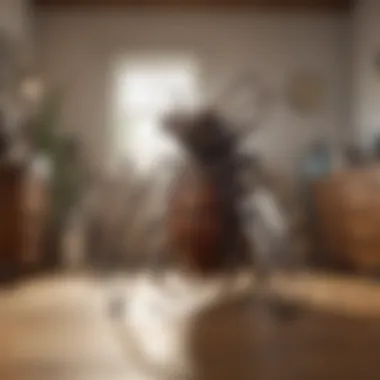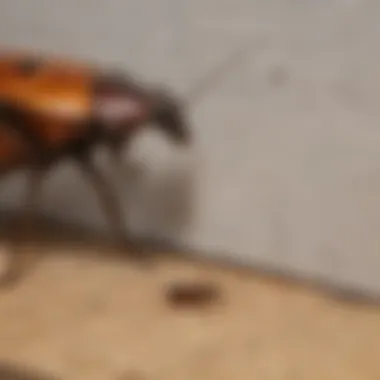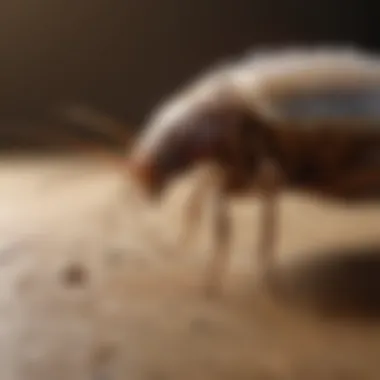Fumigate Your House for Roaches: A Comprehensive Guide


Intro
Fumigating a house for roaches is important for effective pest management. Understanding this process can mitigate infestations and improve your home environment. Roaches are not just unsightly; they can pose health risks. They carry allergens and can spread disease. Hence, identifying them and knowing how to eliminate them is crucial for homeowners.
Pest Identification
Common Household Pests
Roaches are part of common household pests. Among them, the German cockroach and American cockroach are frequent culprits in many homes. German cockroaches are smaller. They prefer warm, humid places, often found in kitchens and bathrooms. American cockroaches, larger and reddish-brown, tend to wander and may be seen in basements or around drains.
Signs of Infestation
Identifying a roach infestation involves noting specific signs. Look for droppings, which resemble coffee grounds or black pepper. Another indicator is the presence of egg cases, known as oothecae, which are brown or black and contain multiple eggs. Unpleasant, musty odors can also signal an infestation. Regularly check these signs to gauge the severity of your problem.
Prevention Methods
Environmental Modifications
Preventing a roach infestation starts with environmental modifications. Keep food sealed and stored properly. Clean up crumbs and spills immediately. Roaches thrive in dirty spaces, so regular cleaning of surfaces is necessary. Seal cracks and crevices in walls and around plumbing. This reduces potential entry points for roaches.
Home Maintenance Tips
Routine home maintenance is crucial. Check for leaks, as moisture attracts roaches. Ensure that garbage bins have tight-fitting lids. It’s also wise to inspect packages or bags brought from outside, as they may carry unwanted pests. Regular lawn maintenance can help control roaches coming from outside.
DIY Pest Control Solutions
Natural Remedies
Some homeowners prefer natural remedies for pest control. Essential oils, like peppermint or tea tree, can repel roaches. Mix a few drops with water in a spray bottle to create a natural repellent. Boric acid, if used cautiously, can be effective. It dehydrates the roaches, reducing their numbers.
DIY Traps and Barriers
DIY traps can be set up easily to monitor and capture roaches. A common trap involves a mixture of sugar and baking soda. The sugar attracts roaches, and the baking soda kills them. Another method is to create a barrier with sticky tape placed around the home’s perimeter. Use caution—these traps are not meant to control large infestations, but they can help monitor the situation.
Remember: Being proactive is key to effective pest control. Regular inspection and maintenance will help in preventing an infestation from taking hold.
Foreword to Roaches
Understanding roaches is a critical first step in managing infestations effectively. This section will delve into why recognizing the nature and types of roaches is vital for homeowners. Knowledge about these pests equips you with the insight needed to address potential problems before they escalate.
Understanding Roach Infestations
Roach infestations can develop rapidly if not managed timely. These insects are resilient and can thrive in various environments. Roaches prefer dark, moist areas, making kitchens and bathrooms prime locations for their breeding. They reproduce quickly, and a small issue can escalate into an extensive problem in a short period. If you notice a few roaches, it is essential to act quickly.
Special attention must be paid to the signs of infestations, including seeing droppings, egg cases, or a noticeable odor. Recognizing these indicators can save you from larger headaches down the line. Regular inspections can help you stay ahead of the curve, ensuring that a minor annoyance does not morph into an infestation.
Common Types of Roaches
There are several common types of roaches that may invade your home. Understanding these species can help tailor your approach to extermination. Here are a few notable ones:
- American Cockroach: Recognizable by its reddish-brown color, this species prefers warm and moist environments. They can grow quite large.
- German Cockroach: Smaller and lighter in color, they are notorious for their rapid reproduction, making them a common household problem.
- Oriental Cockroach: These roaches are dark brown or black and prefer cooler environments, often found in basements.
- Brown-Banded Cockroach: This species is smaller and prefers higher locations in homes, such as ceilings or light fixtures.
Knowing which type of roach you are dealing with can influence the methods of extermination. Each species has unique habits and preferences that should inform your pest control strategy.
"Education about pest behavior together with proper measures can lead to a more successful pest management approach."


Roaches are more than just annoying pests. They can have significant health implications as they carry bacteria and allergens, potentially impacting you and your family. Understanding their behavior and habits is crucial, as it enables you to take proactive measures, ensuring your living space remains comfortable and safe.
When to Consider Fumigation
Fumigation is a step that should not be taken lightly. It is crucial to identify the right circumstances under which fumigation becomes necessary. When the presence of roaches threatens not only the comfort of your home but also your health, it is time to consider this method. This section will delve into key elements that indicate an impending need for fumigation, along with the benefits and important considerations involved in the process.
Indicators of Severe Infestation
Recognizing the signs of a severe roach infestation is essential for determining when fumigation is an appropriate recourse. There are several indicators you should be aware of:
- Visible Roach Activity: Frequent sightings of roaches during the day usually indicate a large population. Roaches are primarily nocturnal, so if they are seen during daylight, population levels are likely high.
- Droppings and Shed Skin: Finding roach droppings, often resembling black pepper, and discarded skin can point to an infestation.
- Egg Cases: American cockroach egg cases or oothecae are another sign of breeding within your space. They are usually brown and oval-shaped, and their presence suggests a significant roach population.
- Unpleasant Odor: A musty odor can signal the presence of many roaches.
- Damage to Property: Roaches can chew through materials like paper and fabric, so signs of damage may indicate a serious infestation.
If multiple signs are evident, it is best to proceed with fumigation rather than simply relying on DIY solutions.
Health Risks Associated with Roaches
Roaches are more than an inconvenience; they pose various health risks. Their droppings, saliva, and body parts can trigger allergies and asthma. Households with children, the elderly, or immunocompromised individuals should be particularly vigilant. Here are some health concerns related to roaches:
- Allergic Reactions: Many individuals can develop allergic reactions after exposure to cockroach body parts or droppings.
- Asthma Attacks: Research suggests a significant correlation between cockroach allergens and increased asthma symptoms, especially in children.
- Gastrointestinal Illnesses: Cockroaches can carry pathogens like Salmonella and E. Coli, which can lead to foodborne illnesses, especially in contaminated food.
"The presence of roaches within living spaces requires immediate action. Addressing infestations is not merely about pest control; it is about protecting health, well-being, and peace of mind."
Considering these health impacts, fumigation can be justified as a preventive measure to safeguard household members. The decision for fumigation should be informed by the severity of the infestation and the potential health risks.
In summary, recognizing the indicators of a severe infestation and understanding the associated health risks are fundamental steps in determining when to consider fumigation. Acting promptly can save both your home and your health from further detriment.
Preparing for Fumigation
Before starting the fumigation process, proper preparation is essential. This phase is not only about clearing out spaces but also understanding the infestation, ensuring safety, and optimizing the effectiveness of the treatment. Preparing effectively can enhance results and mitigate potential risks associated with the procedure. Here are the significant aspects of this preparatory phase.
Initial Inspection and Assessment
Conducting an initial inspection allows homeowners to gauge the extent of the infestation. A thorough examination identifies areas where roaches are most prevalent. Homeowners should check common hiding spots like kitchens, bathrooms, and basements. Noting where the roaches congregate can help pest control professionals target their efforts. Consider documenting sightings and droppings to share with the exterminator. This information is crucial for developing a tailored fumigation plan, ensuring more comprehensive coverage during treatment.
Clearing the Area
Once the initial inspection is complete, homeowners must clear the fumigation area. Remove items from cabinets, drawers, and under sinks to prevent contamination. It is advisable to move furniture away from walls too. The goal here is to create a clear pathway for the fumigation process. This not only protects personal belongings but also allows the fumigants to disperse evenly throughout the space. Keep in mind that certain items may need special handling, such as electronics or delicate decorations, which should be safely stored away.
Securing Food and Beverages
Food and beverages pose a significant risk during fumigation. Before treatment begins, ensure all food items are securely stored. This includes pantry staples and pet food, as roaches can easily access these. Store items in airtight containers, or relocate them to sealed areas not affected by fumigation. This precaution minimizes the risk of contamination from harmful chemicals. Always check the labels of products used in the fumigation process to understand any necessary precautions regarding food.
Evacuation Protocol
Fumigation typically requires the evacuation of the house for safety. Homeowners should develop a clear evacuation protocol to prepare all occupants. This includes families and pets. It is critical to consult the pest control service for specific timelines regarding how long individuals should remain away from the property. Ensure alternative accommodation is arranged prior to the fumigation, if necessary. Clear communication with all household members about the plan will ease concerns and help maintain order during evacuation.
The Fumigation Process
Fumigation is a critical step in managing a severe roach infestation. It offers an effective way to eliminate not just the visible roaches but also their eggs, which often evade other pest control methods. Understanding how this process works can help homeowners confidently tackle their pest problem. A successful fumigation can lead to a significant reduction in the roach population, thereby improving the overall health and comfort of your household.
Different Fumigation Methods
There are various fumigation methods, each suited to specific situations. The most common are:


- Tenting: This method involves covering the entire house with a tarpaulin. A gas, usually sulfuryl fluoride, is then released into the sealed environment. This method is effective for large infestations but requires homeowners to vacate the premises for several days.
- Localized Fumigation: This technique targets specific areas within the home, such as attics or crawl spaces. It is useful for smaller outbreaks and does not require the entire residence to be evacuated.
- Spot Treatments: Often utilized for small infestations, these methods apply pesticides directly where roaches are found. It requires less time and preparation compared to full-scale fumigation.
Choosing the right method depends on the severity of the infestation and the living situation. Each method has its advantages and considerations, and consulting a professional can provide clarity.
Timing of Fumigation
Timing is another critical factor in the fumigation process. Generally, it is best to schedule fumigation during periods when the house can remain unoccupied for an extended time. This may coincide with family vacations or extended work trips, reducing the disruption to daily life.
Moreover, certain seasons may influence effectiveness. Roaches tend to be more active in warm weather, making it a suitable time for treatment. However, it is important to work with professionals who can recommend specific timing based on the roach activity patterns observed in your area.
Monitoring Effectiveness
Post-fumigation monitoring is essential to ensure that the treatment has worked effectively. Homeowners should conduct regular inspections following the fumigation process. Look for signs of dead roaches or any fresh droppings in areas where infestations previously occurred.
- Follow-Up Inspections: Schedule a follow-up visit with a pest control professional to assess the effectiveness of the treatment.
- Ongoing Monitoring: Use traps to catch any remaining roaches and to identify potential re-infestation quickly.
Understanding effectiveness can dictate future pest management strategies. If problems persist, further consultation might be necessary to recalibrate the approach to eliminate the pests entirely.
Post-Fumigation Activities
Post-fumigation activities play a critical role in ensuring the efficacy of the fumigation process and the safety of your home environment. After a fumigation treatment, it is essential to follow certain steps to promote recovery and maintain a pest-free home. Neglecting these activities can compromise the benefits achieved through fumigation, making it vital to understand their importance and execute them properly.
Returning Home Safely
Once the fumigation process is completed, the primary concern is to return home in a safe manner. Before entering your house, it is crucial to wait for the specified duration that pest control professionals recommend. This waiting period is an integral part of the treatment, allowing chemicals to settle and dissipate in the air. Failure to adhere to these guidelines can lead to exposure to harmful residues.
- Check for Warning Signs: Upon returning, inspect the house for any posted warning signs about chemical exposure.
- Ventilation: Open windows and doors immediately to allow fresh air to circulate. This step helps in diluting any remaining pesticide residue in the air.
- Monitoring Your Health: Pay attention to any allergic reactions or respiratory symptoms upon re-entering. If you experience discomfort, it is advisable to leave and contact a medical professional if necessary.
Clearing Residual Chemicals
Post-fumigation, addressing residual chemicals is of utmost importance. While the aim of fumigation is to eliminate roaches, it is also essential to reduce the presence of any harmful substances left behind. Here are some recommended actions:
- Surface Cleaning: After adequate ventilation, wipe down surfaces in your kitchen and living areas. Use mild soap and water to clean countertops, tables, and other frequently touched surfaces. This action minimizes potential residue that could linger after fumigation.
- Dispose of Food Items: If any food items were left uncovered during the fumigation process, it is safer to discard them. Even if they are in sealed packages, it is better to limit exposure to chemical residues.
- Safety with Pets: If you have pets, consult with your pest control provider about the safety protocols for them. Ensure they do not return home until it is confirmed that all chemicals have settled.
By adhering to these post-fumigation activities, homeowners can significantly enhance the safety and cleanliness of their living environment while effectively protecting their homes from future infestations.
Ongoing Prevention Measures
Ongoing prevention measures are crucial in maintaining a roach-free environment after fumigation. They establish a proactive approach to pest management, reducing the likelihood of future infestations. Regular vigilance saves homeowners from the stress, costs, and health hazards associated with re-infestation. Regular feedback on the effectiveness of these measures can lead to improved strategies, tailored to the specific environment of the home.
Regular Cleaning Routines
A consistent cleaning routine plays an integral role in preventing roaches from returning. Roaches thrive in environments where food particles and moisture are readily available. Household chores should focus on removing potential food sources. Areas like kitchens and dining rooms require special attention. This includes:
- Wiping surfaces daily: Clean countertops, tables, and floors to remove food residues.
- Storing food appropriately: Use airtight containers for food storage.
- Taking out the trash regularly: Dispose of trash daily to avoid attracting roaches.
Even the smallest crumbs can serve as nourishment for these pests. Therefore, maintaining cleanliness is not merely about aesthetics; it’s a vital preventative measure.
Sealing Entry Points
Sealing entry points is essential in blocking roaches from entering the home. These pests can exploit tiny gaps and cracks in walls, floors, and windows. Homeowners should undertake a thorough inspection of their dwelling to identify troublesome spots. Consider:
- Caulking gaps in walls and around windows.
- Installing door sweeps on exterior doors to close off gaps underneath.
- Repairing any damaged screens in windows or vents.


These efforts create a physical barrier against roaches, significantly lowering the chances of infestation.
Monitoring for Signs of Infestation
Continuous monitoring for signs of infestation is an often-overlooked aspect of pest management. Homeowners should be alert to the visual clues that indicate a resurgence of roaches. Some important indicators include:
- Droppings: Small, dark spots resembling coffee grounds.
- Egg cases: Oval-shaped and usually found in hidden corners.
- Musty odors: An unusual smell can indicate roach presence.
By being attentive to these signs, homeowners can act swiftly if signs of infestation arise. Early detection can make the difference between a minor issue and a significant infestation.
"Being proactive in pest control is key. Preventative measures can save you from costly extermination in the future."
In summary, ongoing prevention measures such as establishing regular cleaning routines, sealing entry points, and vigilant monitoring are effective strategies for keeping roach populations at bay. These combined efforts contribute to a healthier living environment, ensuring long-term comfort and safety in the home.
Alternative Pest Control Solutions
In dealing with roach infestations, it is essential for homeowners to consider various pest control solutions. While fumigation is a powerful method, it is not the only option available. Exploring alternative pest control solutions can provide flexibility and effectiveness tailored to specific situations. The alternative methods range from do-it-yourself options to professional services, each with its advantages and considerations.
DIY Pest Control
DIY pest control offers homeowners an accessible and often cost-effective approach to managing roach problems. This method allows individuals to apply their own tactics and products without the need for professional intervention.
Some common DIY solutions include:
- Boric Acid: This naturally occurring compound is effective when applied where roaches are known to frequent. It is vital to follow the instructions carefully.
- Diatomaceous Earth: A natural powder that can dehydrate and kill roaches when they come into contact with it. It is essential to apply it in thin layers for best results.
- Glue Traps: These traps can capture roaches and provide a clear indication of the infestation level. Checking traps regularly assists in monitoring the situation.
Homeowners should weigh the effectiveness of DIY methods against potential limitations. DIY solutions are suitable for minor infestations. However, significant infestations often require a more aggressive approach.
Professional Pest Control Services
When infestations become severe, engaging professional pest control services is another viable solution. Professionals are trained to assess the severity of the infestation and implement appropriate treatment plans, including both fumigation and alternative methods.
The benefits of professional services include:
- Expert Assessment: Professionals understand roach behavior and can identify problem areas within the home that might be overlooked by homeowners.
- Targeted Treatments: Using advanced techniques and products, experts can deliver treatment that is more effective than many over-the-counter options.
- Ongoing Monitoring: Many services offer post-treatment follow-ups to ensure effectiveness and prevent reinfestation.
However, when choosing a pest control service, consider reviewing their credentials and past customer feedback. Confirming their approach aligns with your preferences ensures a suitable match for your needs.
"Investing in professional pest control can save homeowners more time and money in long run, especially during severe infestations."
Closure
Addressing roach infestations in your home is crucial for maintaining a healthy living environment. This article has detailed the specific benefits of fumigation, which can provide a long-lasting solution to a pervasive problem. By understanding the fumigation process, preparing properly, and engaging in ongoing pest management strategies, homeowners can significantly reduce the risks associated with roaches.
Summarizing Fumigation Benefits
Fumigation is a powerful method against roaches. It involves the application of gaseous pesticides in an enclosed area, ensuring that even the most hidden pests are eliminated. One major benefit is its effectiveness in tackling severe infestations. Unlike spot treatments that may leave certain areas untreated, fumigation penetrates all corners of your home, ensuring comprehensive elimination.
Additionally, fumigation minimizes the exposure of residents to harmful chemicals since it is a contained process. Before returning home, you can be assured that any chemicals used would have dissipated. This makes fumigation a safer option compared to ongoing pesticide treatments.
Other benefits include:
- Long-lasting results: Fumigation can provide a longer-term solution than other pest control methods.
- Convenience: Once the process is complete, minimal follow-up is needed compared to traditional methods where repeats may be necessary.
- Coverage of hard-to-reach areas: Fumigation effectively treats areas that are often overlooked during routine cleaning or spot treatments.
"Fumigation is not just elimination but a key step towards ensuring your home is pest-free for the long run."
Final Thoughts on Pest Management
The process of managing pests, particularly roaches, demands a systematic approach. Fumigation is an integral part of this strategy. Alongside regular cleaning, sealing potential entry points, and monitoring for signs of infestation, it forms a holistic pest management plan.
Furthermore, awareness of the recurring nature of pest issues is vital. Roaches can return if not properly managed through preventative measures. This makes ongoing vigilance a necessity for homeowners.















